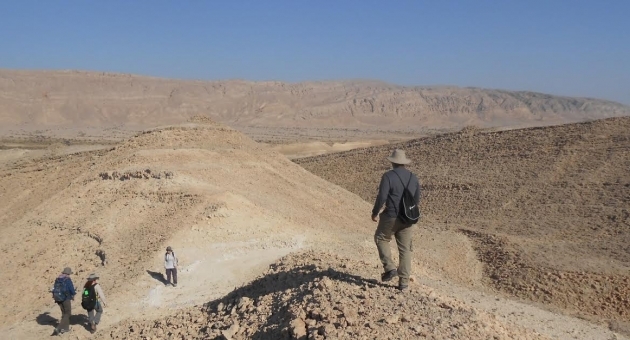
Temple students Paige Randazzo, Class of 2017, and Marvin Fequiere, Class of 2015, spent their winter break in northern Oman. While there, the pair unearthed the 5,000-year-old skeleton of a child from a stone tomb atop a cliff on the Arabian Peninsula.
“It was everything I have ever wanted,” Randazzo, an anthropology major from Lafayette, New Jersey, said of the experience. “At the same time, it was scary, because I knew these bones were a person and I was responsible for handling them and that they could break because they were so old.”
The duo were among six undergraduates from Temple who were taking part in bioarchaeology training as part of the Social, Spatial, and Bioarchaeological Histories of Ancient Oman (SoBO) project. Bioarchaeology is the study of human skeletal remains from archaeological sites for the purpose of reconstructing past human activities and health patterns. The SoBo project analyzes the area’s shifting Bronze Age mortuary traditions.
Kimberly Williams, an assistant professor of anthropology and a skeletal biologist, launched the project in 2010 after she received a Temple Faculty Senate Seed Money Fund grant and a National Science Foundation grant, which continues to fund the project and the students’ field experiences.
This year, the SoBO team also included Temple graduate student and research assistant Megan Luthern; the project’s co-director, Lesley Gregoricka, a bioarchaeologist from the University of South Alabama; three of Gregoricka’s students; a resident of an Omani village close to the dig site; and a member of Oman’s Ministry of Heritage and Culture.
Besides skeletal remains, over the course of five seasons of fieldwork the excavations of more than 20 tombs have uncovered ceramics from Mesopotamia, carnelian beads from southern Asia’s Indus Valley and locally made bronze swords, daggers and personal ornaments.
“The Mesopotamians wanted bronze [a copper alloy]. There is evidence of copper mining and smelting, and of exporting the resulting bronze to Mesopotamia and beyond,” said Williams.
“What’s fascinating is that, at the same time you have great civilizations nearby, this was a not-well-documented hinterland populated by workaday people who, in the grand scheme of history, far outnumber the elite,” she said. “We want to understand the role of these relatively invisible people.”
Williams said the fieldwork trains her students to employ the scientific method in the real world, developing and testing hypotheses and adapting them to the conditions they encounter and the data they generate.
It also allows her students to determine if they have the requisite passion for scientific fieldwork. For example, Fequiere, an anthropology major from northeast Philadelphia, plans to return with Williams to Oman both for a dig in May and one next winter.
Likewise, Nurvidia A. Rosario, Class of 2015, an anthropology major from South Philadelphia, said she found her niche cleaning skeletons in the Oman laboratory. She now intends to pursue a graduate degree in bioarchaeology.
“You start thinking about these people as actual persons, wondering, ‘Who were they and what were they like?’” said Rosario. “From the way they were buried it’s obvious that they had people who cared about them. It also says a lot about the human experience.”
Randazzo, who received a university Creative Arts, Research and Scholarship grant to fund her honors thesis on erosional effects on the tombs, had a similar epiphany: “When I was out there, I knew I had to be a bioarchaeologist. I got this peaceful feeling knowing I was in the right place.”
-Bruce E. Beans